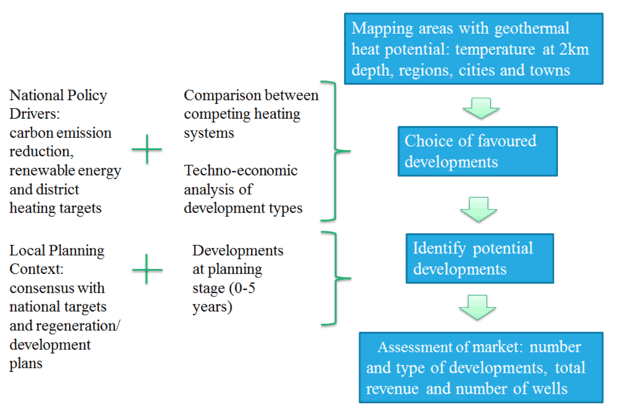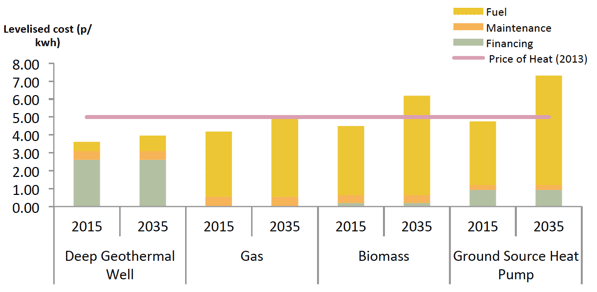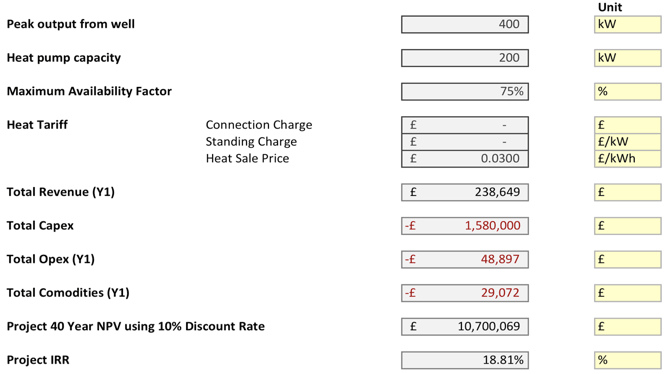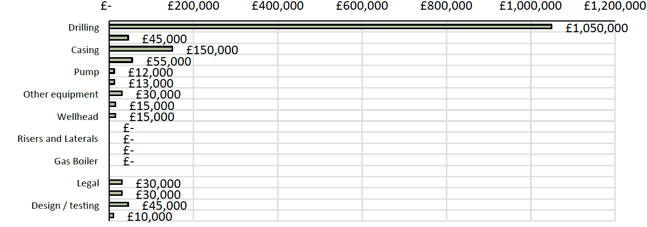Feasibility Report of a Deep Geothermal Single Well, Aberdeen Exhibition and Conference Centre
Report of study which examined the technical, logistical, contractual and economic feasibility of installing a deep geothermal single well system at the new site of the Aberdeen Exhibition and Conference Centre.
Commercial Potential and Roll Out
Overall Market, Constraints and Strategy
The overall commercial opportunity for the DGSW system is the market for heat supply in multiple apartment buildings, offices, leisure centres, anaerobic digestion plants and small heat networks associated with university buildings and schools. Key drivers for the DGSW are national and local targets for renewable energy along with long term security of heat price. The policy targets underpin the market assessment and are summarised in Figure 26.
Figure 26: Methodology for the market study

Policy Drivers
Table 7 below presents a summary of the main relevant national policies and regulations and an indication of the implications of each for the DGSW system.
Table 7: Policy drivers for the DGSW
| Policy and Regulation | Scope | Measure | Implication for geothermal heat |
|---|---|---|---|
| Climate Change Act | UK | UK has set legally binding target to reduce GHG emissions by 80% by 2050 from 1990 levels. | Renewable energy will be key reducing UK GHG emissions. Geothermal heat is one of the most low carbon heat sources available. |
| Renewable Energy Target | UK | UK has set a target to generate 15% of energy supply from renewable sources. | Geothermal heat is a viable renewable energy source. |
| EU Energy Performance in Buildings Directive | European Union | Requires that all new public buildings are "nearly zero energy" by 2018 and all other new buildings meet that standard by 2020. | On-site renewable energy will be key to meeting that standard. Therefore DGH as a widely available renewable heat source will be very attractive to planners and developers in the lead up to these dates. |
| UK Government Plan for Growth | UK | Commitment to support "increased investment in low carbon technologies". | General statement of policy support. |
| The Future of Heating: A strategic framework for Low Carbon Heat in the UK | UK | Emphasis on the phasing out of gas supplied heat over time for domestic and non-domestic buildings, with DH networks covering urban areas and heat pumps serving lower density areas | Geothermal highlighted as a potential contributing technology to DH networks. Contribution potential is suggested to be minor. |
| Renewable Heat Incentive | UK | Payment for heat generation from renewable sources, set by the government and administered by Ofgem. Funding provided by the Treasury. Based on amount of heat generated, with average returns of 12% per annum. No size cap. | Deep geothermal heat is currently supported in the RHI through the deep geothermal tariff of circa 5p/kWh. Scottish Government focus on promoting the Renewable Heat Incentive. |
| Scottish Government - Heat Policy Statement | Scotland | Commitment to Decarbonisation of Heat in Scotland. | Scottish Government keen to see a self sustaining geothermal energy sector developed in Scotland. |
| Energy Performance Certificates | UK | EPCs display regulated the carbon emission per energy use in commercial and domestic buildings (EPCs) or whole building energy use in public sector buildings (DECs) . They enable owners and occupants to see the current energy performance of a building on a scale from A to G, and future potential if energy conservation measures were implemented. | Geothermal Heat would help buildings achieve a higher EPC rating. |
| Scottish Government -National Planning Framework | Scotland | Target of 11% of heat demand to be sourced from renewable sources by 2020. Therefore planning policy will be focussed on supporting low carbon, renewable heat projects. | Geothermal Heat projects should be supported by local authorities. Where current evidence bases underestimate the DGH potential, there may be a case for GEL to promote a revision to the evidence base to correct this error. |
| Aberdeen Local Development Plan | Scotland | Each local planning authority has its own Local Plan which is consistent with National Policy but also reflects local priorities, issues and opportunities for the built environment. The Aberdeen Local Development Plan R7 requires all new buildings to install low and zero carbon generating technology. Plan targets all new buildings to be carbon neutral by 2016. Geothermal Energy included in the eligible technologies to meet the requirements of the policy. | Geothermal Heat would be applicable to "carbon compliance" and "allowable solutions." Geothermal Heat could qualify as a renewable heat source for investment from carbon funds or directly by developers. Further work should be done to identify other leading local planning authorities, particularly in areas of high geothermal energy resource. Air quality policies will put pressure on combustion-based generation technologies such as gas and biomass. This will give DGH a further competitive edge in these locations. Geothermal can be an effective source of low carbon heat. Tightening standards will increase the market demand for such technologies. |
Customer Types
The DGSW is suited to residential or commercial demand profiles such as blocks of flats (100 or more apartments), exhibition centres, warehouses, university campuses, greenhouses and leisure centres. Initial targets for the technology will include new developments with a strong interest in renewable and low carbon energy solutions to meet the greenhouse gas emissions requirements of Building Regulations.
Route to Market
For the DGSW to succeed, it will be important to have a demonstrator site in operation to both raise awareness of the technology and provide an opportunity for potential clients to see the system. Following on from the demonstrator site, the route to market is through the development of a heat utility company. We have recently launched the heat utility company (Geon Energy Ltd) to market and develop commercial opportunities. Shareholders of the company will include GEL and Arup.
Operations and Logistics
An important aspect of the DGSW is the scale of the heat network required for the system. With a peak output of between 400 and 600kW and annual operation of circa 2GWh (60% utilization), the system is well suited to small clusters of buildings or multiple apartments that are owned by a single entity (Council, University, Social Landlord, Leisure Centre operator etc.). The Heat Purchase Agreements and network ownership is therefore simpler than when dealing with a much larger network connected to multiple building and land owners. The standard approach we are taking to projects is a turnkey Heat Purchase Agreement and a Special Purpose Vehicle (SPV) heat company that is owned by the local community/ building owner and Geon Energy Ltd.
Intelectual Property
There are currently no specific aspects of the DGSW that can be patented. This has been confirmed by DEHNS (Patent Attorneys at Law). During the development of the technology over the next decade there are likely to be some aspects of the DGSW/ building interface control system that can be patented and this is something that we will consider as projects develop. In the short term GEL and Arup will continue to develop in house 'know how' to maintain first mover advantage.
Competitive Analysis
Compared to other forms of heat supply (both renewable and other), the DGSW can offer guaranteed, secure long-term energy costs. A comparison of existing heating technologies was undertaken in 2015 and the results are summarised in the graphics below. Figure 27 shows the competitive cost of the technology in the short and long term. Over a 20 year period (2015 to 2035) the levelised cost of a DGSW is expected to increase very little compared with the costs of producing heat from other technologies. This is due to the anticipated rise in the cost of fuel required for these alternative technologies.
Figure 27: Comparison of levelised cost of heat (over 20 years) in 2015 and 2034 - alternative technologies

Financial Models
The proposed DGSW at the AECC is foremost a demonstrator system and will therefore be more expensive than a typical DGSW installation. This is due to the extended testing programme and the additional time required for the permitting associated with the first project of its kind in Scotland. For a typical DGSW in Scotland we have developed a detailed financial model for the installation and operation of the system over a 50 year period. The model has been summarised below in Table 8, Figure 28, Figure 29, Figure 30 and Figure 31. The results show that, provided the Renewable Heat Incentive remains in place, the return to investors is at an acceptable level for equity or debt funding. We already have a very strong appetite from investors for this type of technology once a demonstrator project has been proven in Scotland.
Table 8: Summary of project financials for a typical DGSW system with an annual utilisation rate of 75%

Figure 28: Operating costs for a typical DGSW system
Operating Costs and Commodites

Figure 29: Project revenues for a typical DGSW system
Project Revenues

Figure 30: Capital cost breakdown for a typical DGSW system
Capital Costs

Figure 31: Cash flows for a typical DGSW installation
Project Cashflows (Excluding Financing)

Contact
Email: Johann MacDougall
There is a problem
Thanks for your feedback